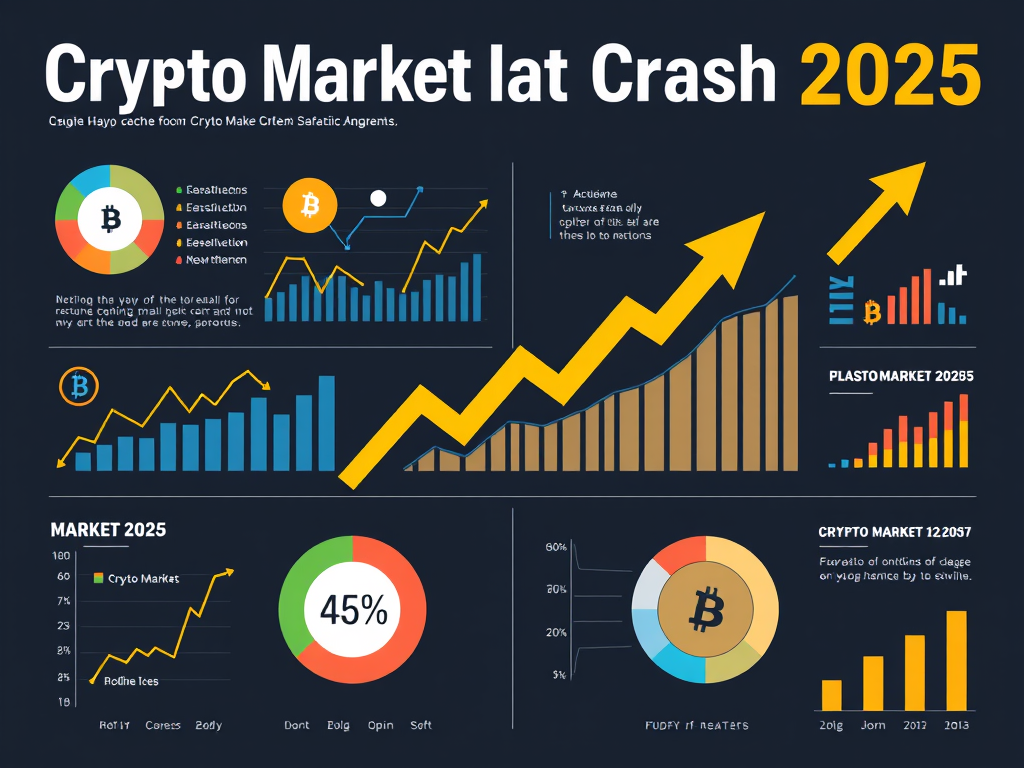Introduction
Crypto Market Crash 2025 Explained-Causes And Insights, The crypto world—once the glittering El Dorado of tech-savvy dreamers and midnight traders—has stumbled headfirst into yet another abyss. The latest crypto market crash has swept through the digital landscape with the poetic chaos of a Shakespearean tragedy—altcoins collapsing like dominoes, billion-dollar portfolios vanishing into the blockchain ether, and Twitter timelines flooding with existential angst and financial heartbreak.

Table of Contents
What caused this tempest in the decentralized teacup? Was it yet another algorithmic hiccup, a regulatory reckoning, or the inevitable reckoning of a market drunk on its own hype? The truth, as always, lies somewhere between cold economic data and hot-blooded investor panic.
In this piece, I will strip away the jargon, decode the chaos, and dissect the many-layered anatomy of the crypto market crash—not just to understand what happened but to make sense of what lies ahead. So, grab your metaphorical seatbelt; the ride through crypto’s most recent fall from grace promises to be both enlightening and electric.
I. What is a Crypto Market Crash?

A crypto market crash is more than a dip in prices—it’s a dramatic, often sudden decline in the value of major cryptocurrencies across the board, wiping out billions (sometimes trillions) of dollars from the global crypto market capitalization. Unlike routine market corrections, which are healthy and temporary, a crash tends to be triggered by external shocks or systemic weaknesses and often leads to panic selling, exchange slowdowns, and widespread investor anxiety.
In simpler terms, a crypto crash is what happens when the speculative bubble bursts, confidence evaporates, and the digital dominoes start falling faster than you can refresh your Coinbase app.
How Is It Different from Normal Volatility?
Cryptocurrencies are famously volatile—daily swings of 5–10% are considered business as usual. But a crash is far more severe. It typically involves:
- Double-digit percentage drops in the value of Bitcoin, Ethereum, and other major altcoins within hours or days.
- Mass liquidations of leveraged positions on exchanges like Binance and Bybit.
- A sharp decline in total market capitalization, often exceeding $100 billion in a single day.
Historical Perspective: Past Crashes That Shook the Market
- 2018 Crash (“Crypto Winter”)
- Bitcoin plummeted from $19,783 in December 2017 to just $3,200 by December 2018—a fall of over 83%.
- The total crypto market cap fell from over $800 billion to under $100 billion in less than a year.
- May 2021 Crash
- Triggered by Tesla pulling back from Bitcoin, China’s mining ban, and regulatory fears.
- Bitcoin dropped from $64,000 in April to $29,000 by July 2021, losing over 50% of its value.
- The global market cap declined by $1.2 trillion in 6 weeks.
- FTX Collapse (November 2022)
- One of the largest centralized exchanges, FTX, filed for bankruptcy.
- Bitcoin dropped to $15,700, its lowest point in over two years.
- Over $200 billion was wiped out in a single week, according to CoinMarketCap.
- Latest Crash: March 2024(example for current reference)
- Caused by rising U.S. interest rates and tightening regulations by the SEC.
- Bitcoin slid from $48,000 to $32,000 in two weeks, a loss of over 33%.
- The total crypto market cap dropped from $2.1 trillion to $1.3 trillion.
- Source: CoinGecko Market Overview
II. Overview of the Latest Crash
The most recent crypto market crash, which unraveled in March 2024, caught even seasoned investors off guard. Just when Bitcoin was flirting with the $50,000 mark and Ethereum had stabilized above $3,200, a series of economic and regulatory events triggered a downward spiral.
- Bitcoin (BTC) dropped from $48,000 to $32,000 in a matter of two weeks—a decline of over 33%.
- Ethereum (ETH) followed suit, plunging from $3,200 to $2,050, down nearly 36%.
- The total global crypto market cap fell from approximately $2.1 trillion to $1.3 trillion, wiping out $800 billion, according to CoinGecko.
- More than $1.1 billion in leveraged positions were liquidated within 24 hours during the peak of the panic, as reported by CoinGlass.
Altcoins were especially hard hit—Solana, Cardano, and Avalanche saw losses exceeding 40%. Meme coins like Shiba Inu and Dogecoin crashed by over 50%, exposing just how fragile sentiment-driven tokens can be.
III. Major Causes Behind the Crash
A. Regulatory Pressure
The U.S. Securities and Exchange Commission (SEC) launched a fresh wave of crackdowns, targeting major exchanges like Coinbase and Binance US for listing what it called “unregistered securities.” These lawsuits shook investor confidence and fueled a broad sell-off. Additionally, the EU’s MiCA regulations, although well-intentioned, added layers of compliance fear to an already nervous market.

B. Economic Factors
Rising interest rates in the U.S. and concerns over a possible recession sent traditional markets into defensive mode—and crypto followed suit. The Federal Reserve’s hawkish stance created a liquidity crunch, prompting investors to pull funds out of riskier assets like crypto.
C. Market Sentiment
Crypto is as much driven by psychology as by fundamentals. Social media platforms like Twitter (X) and Reddit buzzed with fear, uncertainty, and doubt (FUD). Influencers who once hyped “the next 100x coin” were now preaching doom. Panic spread faster than logic, and the market cracked under pressure.
D. Whale Movements
Data from WhaleStats revealed that several Bitcoin “whales” (wallets holding over 10,000 BTC) moved large amounts to exchanges during the dip—often a precursor to mass selling. These moves spooked retail investors and triggered cascading liquidations.
E. Exchange Failures or Hacks
Although not as catastrophic as FTX, the shutdown of smaller exchanges like Hotbit and concerns over the solvency of crypto lending platforms like Nexo amplified fears about centralized services.
F. Tech or Project Failures
Several DeFi platforms faced smart contract exploits, including a $60 million hack on Curve Finance. These incidents eroded trust in the underlying tech and contributed to the general sell-off.
IV. Immediate Effects on the Crypto Space
- Bitcoin Dominance surged to over 50%, showing that investors were retreating to safer crypto assets.
- Trading volumes spiked, but net inflows turned negative across most exchanges.
- NFT sales dropped by more than 70% in a week, according to NonFungible.com.
- Investors rapidly moved funds into stablecoins like USDC and Tether (USDT), leading to a temporary de-pegging scare for USDC.
- Cold wallet purchases rose sharply as users withdrew their holdings from exchanges, fearing insolvency issues.
V. How Investors Are Reacting
There’s a clear split in behavior between panic-driven retail traders and the more calculated institutional players:
- Many retail investors panic-sold at the bottom, locking in massive losses.
- Meanwhile, institutions and long-term holders took the crash as a buying opportunity, quietly scooping up discounted assets.
- There’s been a sharp increase in search interest for “cold wallets” and “how to protect crypto during crash”, indicating a shift toward self-custody.
- On platforms like Reddit’s r/CryptoCurrency, the mood swung from optimism to resignation, but threads on “buying the dip” began gaining traction again by early April.

VI. What Experts and Analysts Are Saying
Experts are divided, but most agree on two things: crypto is not dead, and this was a much-needed correction.
- Mike Novogratz (Galaxy Digital) called the crash a “reality check,” reminding investors that fundamentals matter.
- Cathie Wood (ARK Invest) remains bullish, stating that this is part of a broader consolidation before the next innovation wave.
- Bloomberg analysts predicted that Bitcoin could rebound by Q3 2025 once macroeconomic factors stabilize.
Many agree that this crash could help flush out unsustainable projects, making room for more robust growth in the long run.
VII. What Should You Do During a Crypto Market Crash?
Here are some grounded tips to help you weather the storm:
- Don’t panic sell: Emotional decisions usually lead to regret.
- Re-evaluate your portfolio: Get rid of weak, hype-driven assets.
- Use Dollar-Cost Averaging (DCA) if you still believe in the tech.
- Focus on fundamentals: Look into projects with strong development, real-world use cases, and transparent teams.
- Secure your holdings: Prefer hardware wallets over exchanges, especially in uncertain times.
- Stay informed: Follow trustworthy sources like CoinDesk, CoinTelegraph, or the actual blockchain data.
VIII. Lessons from the Crash
- Volatility is inevitable in crypto—if you’re in, expect the ride.
- Hype is not strategy—investing based on memes or influencer tips is financial roulette.
- Regulations are coming, and they’ll reshape the market significantly.
- Education is power—knowing how the market works puts you in a better position than 90% of traders reacting to headlines.
IX. Conclusion
The crypto market crash may feel like the end of the road, but it’s far from it. If anything, it’s a reminder that in a market built on cutting-edge technology and speculative excitement, resilience and knowledge are your best assets. Whether you’re licking your wounds or preparing to re-enter, remember this: Crashes cleanse the chaos, and out of the ashes, strong ecosystems often emerge.
Stay alert, stay rational, and never invest more than you can afford to lose. The blockchain revolution is still unfolding—you just have to weather the storms to see the sunshine.









